I want to learn OpenGL, and decided to start with a very simple example - rendering the shape of comet Wild 2 as inferred from measurements from the Stardust spacecraft (details about the data in: http://nssdc.gsfc.nasa.gov/nmc/masterCatalog.do?ds=PSSB-00133). Please keep in mind that I know absolutely NOTHING about OpenGL. Some Google-fu helped me get as far as the code presented below. Despite my best efforts, my comet sucks:

I would like for it to look prettier, and I have no idea how to proceed (besides reading the Red book, or similar). For example:
- How can I make a very basic "wireframe" rendering of the shape?
- Suppose the Sun is along the "bottom" direction (i.e., along -Y), how can I add the light and see the shadow on the other side?
- How can I add "mouse events" so that I can rotate my view by, and zoom in/out?
How can I make this monster look prettier? Any references to on-line tutorials, or code examples?
I placed the source code, data, and makefile (for OS X) in bitbucket:
hg clone https://arrieta@bitbucket.org/arrieta/learning-opengl
The data consists of 8,761 triplets (the vertices, in a body-fixed frame) and 17,518 triangles (each triangle is a triplet of integers referring to one of the 8,761 vertex triplets).
#include<stdio.h>
#include<stdlib.h>
#include<OpenGL/gl.h>
#include<OpenGL/glu.h>
// I added this in case you want to "copy/paste" the program into a
// non-Mac computer
#ifdef __APPLE__
# include <GLUT/glut.h>
#else
# include <GL/glut.h>
#endif
/* I hardcoded the data and use globals. I know it sucks, but I was in
a hurry. */
#define NF 17518
#define NV 8761
unsigned int fs[3 * NF];
float vs[3 * NV];
float angle = 0.0f;
/* callback when the window changes size (copied from Internet example) */
void changeSize(int w, int h) {
if (h == 0) h = 1;
float ratio = w * 1.0 / h;
glMatrixMode(GL_PROJECTION);
glLoadIdentity();
glViewport(0, 0, w, h);
gluPerspective(45.0f, ratio, 0.2f, 50000.0f); /* 45 degrees fov in Y direction; 50km z-clipping*/
glMatrixMode(GL_MODELVIEW);
}
/* this renders and updates the scene (mostly copied from Internet examples) */
void renderScene() {
glClear(GL_COLOR_BUFFER_BIT | GL_DEPTH_BUFFER_BIT);
glLoadIdentity();
gluLookAt(0.0f, 0.0f, 10000.0f, /* eye is looking down along the Z-direction at 10km */
0.0f, 0.0f, 0.0f, /* center at (0, 0, 0) */
0.0f, 1.0f, 0.0f); /* y direction along natural y-axis */
/* just add a simple rotation */
glRotatef(angle, 0.0f, 0.0f, 1.0f);
/* use the facets and vertices to insert triangles in the buffer */
glBegin(GL_TRIANGLES);
unsigned int counter;
for(counter=0; counter<3 * NF; ++counter) {
glVertex3fv(vs + 3 * fs[counter]); /* here is where I'm loading
the data - why do I need to
load it every time? */
}
glEnd();
angle += 0.1f; /* update the rotation angle */
glutSwapBuffers();
}
int main(int argc, char* argv[]) {
FILE *fp;
unsigned int counter;
/* load vertices */
fp = fopen("wild2.vs", "r");
counter = 0;
while(fscanf(fp, "%f", &vs[counter++]) > 0);
fclose(fp);
/* load facets */
fp = fopen("wild2.fs", "r");
counter = 0;
while(fscanf(fp, "%d", &fs[counter++]) > 0);
fclose(fp);
/* this initialization and "configuration" is mostly copied from Internet */
glutInit(&argc, argv);
glutInitDisplayMode(GLUT_DEPTH | GLUT_DOUBLE | GLUT_RGBA);
glutInitWindowPosition(0, 0);
glutInitWindowSize(1024, 1024);
glutCreateWindow("Wild-2 Shape");
glEnable(GL_LIGHTING);
glEnable(GL_LIGHT0);
glEnable(GL_DEPTH_TEST);
GLfloat mat_specular[] = { 1.0, 1.0, 1.0, 1.0 };
GLfloat mat_shininess[] = { 30.0 };
GLfloat light_position[] = {3000.0, 3000.0, 3000.0, 0.0 };
glClearColor (0.0, 0.0, 0.0, 0.0);
glShadeModel (GL_SMOOTH);
glMaterialfv(GL_FRONT, GL_SPECULAR, mat_specular);
glMaterialfv(GL_FRONT, GL_SHININESS, mat_shininess);
glLightfv(GL_LIGHT0, GL_POSITION, light_position);
glutDisplayFunc(renderScene);
glutReshapeFunc(changeSize);
glutIdleFunc(renderScene);
glutMainLoop();
return 0;
}
EDIT
It is starting to look better, and I have now plenty of resources to look into for the time being. It still sucks, but my questions have been answered!

I added the normals, and can switch back and forth between the "texture" and the wireframe:

PS. The repository shows the changes made as per SeedmanJ's suggestions.